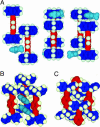Crystalline molecular machines: encoding supramolecular dynamics into molecular structure
- PMID: 16046543
- PMCID: PMC1182427
- DOI: 10.1073/pnas.0502816102
Crystalline molecular machines: encoding supramolecular dynamics into molecular structure
Abstract
Crystalline molecular machines represent an exciting new branch of crystal engineering and materials science with important implications to nanotechnology. Crystalline molecular machines are crystals built with molecules that are structurally programmed to respond collectively to mechanic, electric, magnetic, or photonic stimuli to fulfill specific functions. One of the main challenges in their construction derives from the picometric precision required for their mechanic operation within the close-packed, self-assembled environment of crystalline solids. In this article, we outline some of the general guidelines for their design and apply them for the construction of molecular crystals with units intended to emulate macroscopic gyroscopes and compasses. Recent advances in the preparation, crystallization, and dynamic characterization of these interesting systems offer a foothold to the possibilities and help highlight some avenues for future experimentation.
Figures








Similar articles
-
Crystalline molecular machines: a quest toward solid-state dynamics and function.Acc Chem Res. 2006 Jun;39(6):413-22. doi: 10.1021/ar0680217. Acc Chem Res. 2006. PMID: 16784219
-
The Roles of Intrinsic Barriers and Crystal Fluidity in Determining the Dynamics of Crystalline Molecular Rotors and Molecular Machines.J Org Chem. 2019 Aug 16;84(16):9835-9849. doi: 10.1021/acs.joc.9b00993. Epub 2019 Jun 11. J Org Chem. 2019. PMID: 31141359
-
Controlling Motion at the Nanoscale: Rise of the Molecular Machines.ACS Nano. 2015 Aug 25;9(8):7746-68. doi: 10.1021/acsnano.5b03367. Epub 2015 Aug 4. ACS Nano. 2015. PMID: 26172380 Review.
-
Toward crystalline molecular rotors with linearly conjugated diethynyl-phenylene rotators and pentiptycene stators.J Org Chem. 2012 Sep 7;77(17):7428-34. doi: 10.1021/jo301223q. Epub 2012 Aug 17. J Org Chem. 2012. PMID: 22866873
-
New opportunities in crystal engineering--the role of atomic force microscopy in studies of molecular crystals.Chem Commun (Camb). 2012 Sep 25;48(74):9210-26. doi: 10.1039/c2cc32678g. Epub 2012 Jul 23. Chem Commun (Camb). 2012. PMID: 22822481 Review.
Cited by
-
Phototriggered Complex Motion by Programmable Construction of Light-Driven Molecular Motors in Liquid Crystal Networks.J Am Chem Soc. 2022 Apr 20;144(15):6851-6860. doi: 10.1021/jacs.2c01060. Epub 2022 Apr 5. J Am Chem Soc. 2022. PMID: 35380815 Free PMC article.
-
Correlated motion and mechanical gearing in amphidynamic crystalline molecular machines.Chem Sci. 2020 Oct 21;11(48):12994-13007. doi: 10.1039/d0sc04495d. Chem Sci. 2020. PMID: 34094484 Free PMC article. Review.
-
Ferroelectricity and polarity control in solid-state flip-flop supramolecular rotators.Nat Mater. 2009 Apr;8(4):342-7. doi: 10.1038/nmat2377. Epub 2009 Feb 8. Nat Mater. 2009. PMID: 19202547
-
Electrochemically addressable trisradical rotaxanes organized within a metal-organic framework.Proc Natl Acad Sci U S A. 2015 Sep 8;112(36):11161-8. doi: 10.1073/pnas.1514485112. Epub 2015 Aug 17. Proc Natl Acad Sci U S A. 2015. PMID: 26283386 Free PMC article.
-
Artificial Molecular Machines.Chem Rev. 2015 Sep 23;115(18):10081-206. doi: 10.1021/acs.chemrev.5b00146. Epub 2015 Sep 8. Chem Rev. 2015. PMID: 26346838 Free PMC article. Review. No abstract available.
References
-
- Balzani, V., Credi, A. & Venturi, M. (2003) Molecular Devices and Machines—A Journey into the Nano World (Wiley, Weinheim, Germany).
-
- Stoddart, J. F. (2001) Acc. Chem. Res. 36, 410-411. - PubMed
-
- Howard, J. (2001) Mechanics of Motor Proteins and the Cytoskeleton (Sinauer, Sunderland, MA).
-
- Shilwa, M., ed. (2003) Molecular Motors (Wiley, Weinhein, Germany).
-
- Mish, F. C., ed. (1991) Webster's Ninth New Collegiate Dictionary (Merriam-Wesbter, Springfield, MA).
LinkOut - more resources
Full Text Sources

